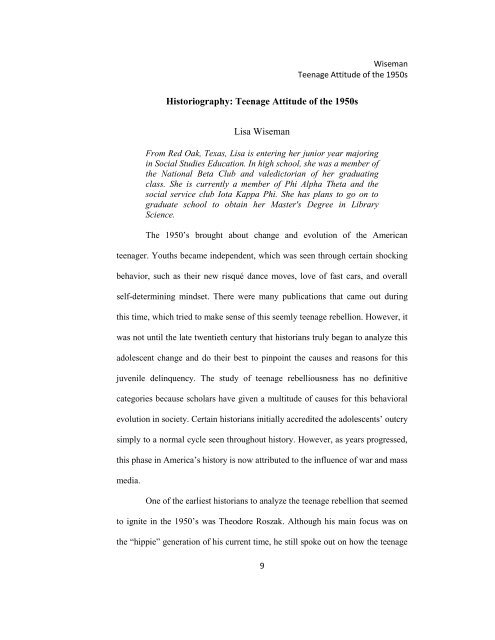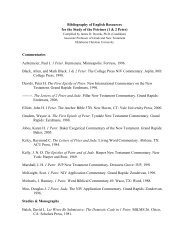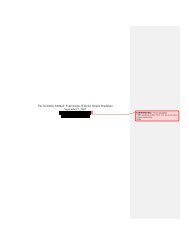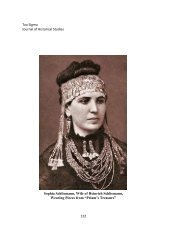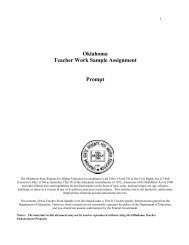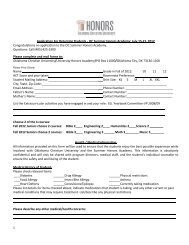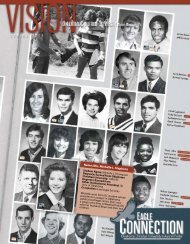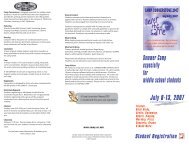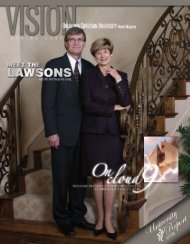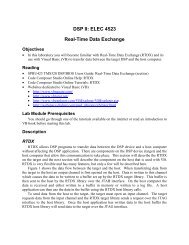Historiography: Teenage Attitude of the 1950s Lisa Wiseman
Historiography: Teenage Attitude of the 1950s Lisa Wiseman
Historiography: Teenage Attitude of the 1950s Lisa Wiseman
You also want an ePaper? Increase the reach of your titles
YUMPU automatically turns print PDFs into web optimized ePapers that Google loves.
<strong>Wiseman</strong><strong>Teenage</strong> <strong>Attitude</strong> <strong>of</strong> <strong>the</strong> <strong>1950s</strong><strong>Historiography</strong>: <strong>Teenage</strong> <strong>Attitude</strong> <strong>of</strong> <strong>the</strong> <strong>1950s</strong><strong>Lisa</strong> <strong>Wiseman</strong>From Red Oak, Texas, <strong>Lisa</strong> is entering her junior year majoringin Social Studies Education. In high school, she was a member <strong>of</strong><strong>the</strong> National Beta Club and valedictorian <strong>of</strong> her graduatingclass. She is currently a member <strong>of</strong> Phi Alpha Theta and <strong>the</strong>social service club Iota Kappa Phi. She has plans to go on tograduate school to obtain her Master's Degree in LibraryScience.The 1950’s brought about change and evolution <strong>of</strong> <strong>the</strong> Americanteenager. Youths became independent, which was seen through certain shockingbehavior, such as <strong>the</strong>ir new risqué dance moves, love <strong>of</strong> fast cars, and overallself-determining mindset. There were many publications that came out duringthis time, which tried to make sense <strong>of</strong> this seemly teenage rebellion. However, itwas not until <strong>the</strong> late twentieth century that historians truly began to analyze thisadolescent change and do <strong>the</strong>ir best to pinpoint <strong>the</strong> causes and reasons for thisjuvenile delinquency. The study <strong>of</strong> teenage rebelliousness has no definitivecategories because scholars have given a multitude <strong>of</strong> causes for this behavioralevolution in society. Certain historians initially accredited <strong>the</strong> adolescents’ outcrysimply to a normal cycle seen throughout history. However, as years progressed,this phase in America’s history is now attributed to <strong>the</strong> influence <strong>of</strong> war and massmedia.One <strong>of</strong> <strong>the</strong> earliest historians to analyze <strong>the</strong> teenage rebellion that seemedto ignite in <strong>the</strong> 1950’s was Theodore Roszak. Although his main focus was on<strong>the</strong> “hippie” generation <strong>of</strong> his current time, he still spoke out on how <strong>the</strong> teenage9
<strong>Wiseman</strong><strong>Teenage</strong> <strong>Attitude</strong> <strong>of</strong> <strong>the</strong> <strong>1950s</strong>Juvenile Delinquent in <strong>the</strong> <strong>1950s</strong>, James Gilbert concurred with O’Neill in that<strong>the</strong> teenagers <strong>of</strong> <strong>the</strong> <strong>1950s</strong> were greatly influenced from being raised by a wargeneration. 3Gilbert took this rebellion down to specifics and wrote about how thosethat grew up during World War II, who later become <strong>the</strong> teenage generation thatseemed to go through so many problems and difficulties, were particularlyaffected by it. Gilbert said <strong>the</strong> change from constant parental involvement to littleor no parental guidance and discipline caused by World War II, with fa<strong>the</strong>rs <strong>of</strong>fto war, mo<strong>the</strong>rs in <strong>the</strong> work force, and children left to fend for <strong>the</strong>mselves,contributed to adolescent problems. He also wrote how <strong>the</strong> resistance to culturalchange in America at <strong>the</strong> time caused <strong>the</strong> youth to question how Americansociety acted out towards those that were different from <strong>the</strong> majority. This made<strong>the</strong>m lose a portion <strong>of</strong> <strong>the</strong>ir respect for <strong>the</strong>ir elders. Gilbert continued with his<strong>the</strong>ory by commenting on <strong>the</strong> extreme amount <strong>of</strong> mass media culture that wasthrown at and naively accepted by <strong>the</strong> youth at <strong>the</strong> time. He thought <strong>the</strong> way <strong>the</strong>media celebrated juvenile delinquency with movies, music, and magazines didnot help s<strong>of</strong>ten <strong>the</strong> outbreak but instead egged on <strong>the</strong>ir behavior.Many historians have agreed with Gilbert and his explanation <strong>of</strong> <strong>the</strong>media outbreak having disastrous effects on <strong>the</strong> teenagers <strong>of</strong> <strong>the</strong> past. Having <strong>the</strong>media suddenly dominating <strong>the</strong>ir lives at such a great extent overwhelmed <strong>the</strong>m.Two historians distinctly analyzed <strong>the</strong> sway <strong>the</strong> cinema carried to influence <strong>the</strong>3 James Gilbert, A Cycle <strong>of</strong> Outrage: America’s Reaction to <strong>the</strong> Juvenile Delinquentin <strong>the</strong> <strong>1950s</strong> (New York: Oxford University Press, 1986).11
Tau SigmaJournal <strong>of</strong> Historical Studies: Vol. XXIteenage generation. First, Thomas Doherty said film was one <strong>of</strong> <strong>the</strong> first forms <strong>of</strong>media to move from mass culture to teen culture. 4 Doherty proceeded to say filmstarted <strong>the</strong> evolution <strong>of</strong> teen idols, which greatly influenced <strong>the</strong> teen mindset <strong>of</strong><strong>the</strong> 1950’s. In 1998, David Sterritt, in his book Mad to Be Saved: The Beats, <strong>the</strong>‘50s, and Film, looked at how movies affected <strong>the</strong> teen culture as well. 5 Heparticularly investigated <strong>the</strong> Beat generation <strong>of</strong> <strong>the</strong> 1950’s and how <strong>the</strong>y becamea cultural “lens” where <strong>the</strong> nontraditional behaviors <strong>of</strong> <strong>the</strong> time were portrayedthrough film. Sterritt concluded that this small group being depicted in moviesencouraged individual and abstract thinking.Grace Palladino continued <strong>the</strong> analysis <strong>of</strong> <strong>the</strong> consequences <strong>of</strong> this mediafocus through <strong>the</strong> attribution <strong>of</strong> <strong>the</strong> main influence <strong>of</strong> teenage independence to<strong>the</strong> serious escalation <strong>of</strong> advertising aimed at adolescents during <strong>the</strong> 1950’s. 6They were told if <strong>the</strong>y would buy certain products, <strong>the</strong>y would be more popularand beautiful. By purchasing <strong>the</strong>se products, which were presented as necessities,teenagers would consequently be able to form <strong>the</strong>ir own special identity.Palladino concluded that <strong>the</strong>se endorsement pressures put an extra andunnecessary strain on teens by exploiting <strong>the</strong>m because <strong>of</strong> <strong>the</strong> advertisers’ greed.In addition, Palladino attributed <strong>the</strong> invention <strong>of</strong> <strong>the</strong> word “teenager” to <strong>the</strong> youthrebellion. When <strong>the</strong> word was coined in 1941, and started to gain in use andpopularity, youth were given a better sense <strong>of</strong> identity, which thus caused <strong>the</strong>m to4 Thomas Doherty, <strong>Teenage</strong>rs and Teenpics: The Juvenilization <strong>of</strong> American MoviesIn <strong>the</strong> <strong>1950s</strong> (Great Britain: Billing and Sons Ltd, 1988).5 David Sterritt, Mad to Be Saved: The Beats, <strong>the</strong> ‘50s, and Film (Carbondale:Sou<strong>the</strong>rn Illinois University Press, 1998).6 Grace Palladino, <strong>Teenage</strong>rs: An American History (New York: BasicBooks, 1996).12
<strong>Wiseman</strong><strong>Teenage</strong> <strong>Attitude</strong> <strong>of</strong> <strong>the</strong> <strong>1950s</strong>crave greater independence.The teenage rebellion <strong>of</strong> <strong>the</strong> <strong>1950s</strong> was a huge concern to <strong>the</strong> adult worldwhen it first came into <strong>the</strong> American culture and continued into extremities.Numerous historians have attributed <strong>the</strong> source <strong>of</strong> this juvenile delinquency tomany different factors throughout <strong>the</strong> years, such as it being a part <strong>of</strong> a normalsocietal cycle, <strong>the</strong> wartime effects adolescents experienced, <strong>the</strong> sway <strong>of</strong> massmedia, and a longing for identity. In order to grasp fully how this rebelliousgeneration came to be, it is important to establish how <strong>the</strong> public received <strong>the</strong>m.By exploring how different individuals, from educated scholars to “EverydayJoes” <strong>of</strong> <strong>the</strong> time, responded to <strong>the</strong> way <strong>the</strong> youth was acting, a betterunderstanding <strong>of</strong> <strong>the</strong>ir attitude and feelings can be grasped.13


